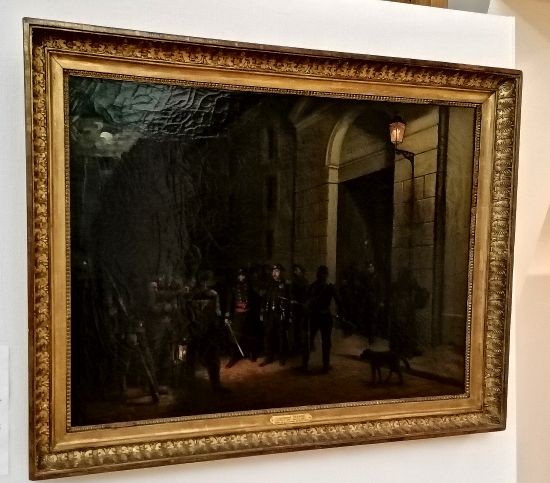THE MUSEUM OF THE WORKING-CLASS BASTION* ONCE HAD A MUCH MORE ACCURATE PRESENTATION
*Communist, 1921- 2020; Social-Democrat since June 2020. Far to the north with a past that is unique: please click.
# # #
There are some strong points:
- Paintings of the time
Anonymous
Communards carrying on the aims of a killed comrade fits the spirit of the sources.
- Photographs and caricatures
- Versailles's point of view
# # #
But modern works replace much more evocative traces of the time kept in the reserve. Why this...
Rather than this?
 |
Corpses of Communard Insurgents by Adolphe Eugène Disderi, the Emperor's photographer |
Blown up and seen figure by figure, the photos of these small and terribly vulnerable men are even more poignant. But it has taken a high-school teacher to do so: Please click and scroll down.
Or this?
"Paris after the Commune" by Frédéric Dix.no date
# # #
Showing Versaillais stress on almost non existent Communard violence would be fine with an explanatory note. But why exhibit two almost interchangeable paintings with no such comment...
Execution of Hostages at the Prison of La Roquette 1871 at 8:00 in the Evening by T. Harreguy
Arrest of an Officer by the Federated National Guard at the Entry of the 8th district's City Hall by Emmanuel Massé, 1870 (That date is impossible: the federated Guard was created on February 15, 1871.)
And added disinformation?
Emmanuel Massé, portraitist and genre painter, here shows an officer of the Empire arrested at the 8th district city hall. Arrests were very frequent, as often by the Communards as by the Versaillais who encircled Paris. [The Versaillais weren't in Paris. How could they arrest?] The prisoners allowed pressure on the adverse camp and the summary executions nourished the insurgents' ardor in their desire for vengeance.
For the reality, please click.
The information in the general descriptive panel could come right out of the Versaillais account:
The shift is part of a general change.
But what was the immediate reason for it
in this stronghold of the left?
End of this sub-section.
* * *
Next,














No comments:
Post a Comment